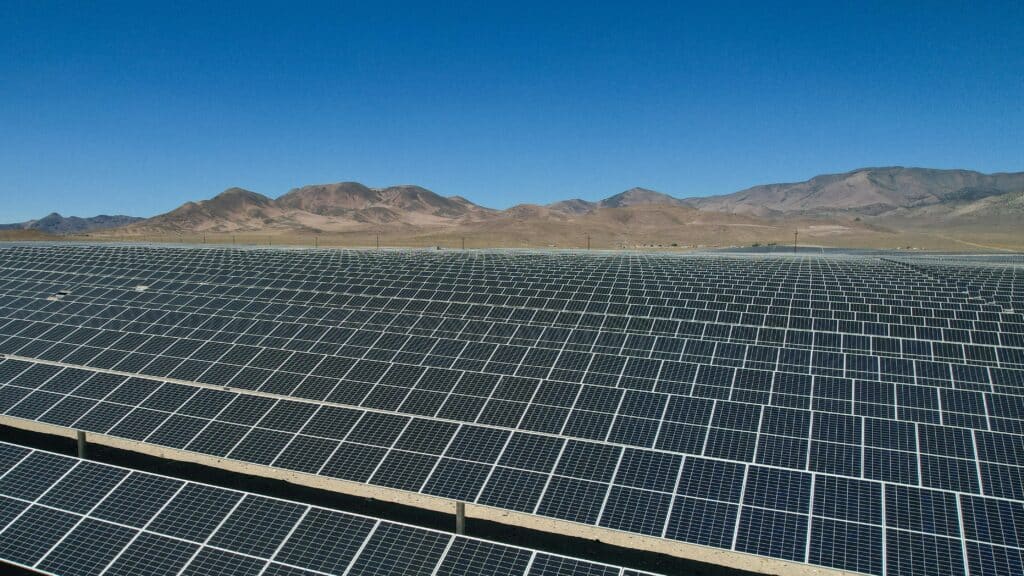POSTED
July 1, 2025
Why Solar Is the Best Energy Solution for Huge AI Energy Demands
Artificial intelligence is no longer a concept of the future; it’s powering the economy today. From generative tools like ChatGPT to data-intensive applications in logistics, healthcare, and manufacturing, AI is transforming every sector. But as AI systems grow smarter, they grow hungrier for power. And the reality is this: the grid wasn’t built for what’s […]

Artificial intelligence is no longer a concept of the future; it’s powering the economy today.
From generative tools like ChatGPT to data-intensive applications in logistics, healthcare, and manufacturing, AI is transforming every sector. But as AI systems grow smarter, they grow hungrier for power. And the reality is this: the grid wasn’t built for what’s coming.
In 2023 alone, U.S. data centers consumed 176 terawatt-hours (TWh)—more than triple their usage from just a decade ago. By 2028, that number could surge to 325–580 TWh, accounting for up to 12% of the nation’s total electricity use, according to the DOE. Some forecasts project that by 2030, data center demand could surpass 600 TWh—more than the entire U.S. manufacturing sector consumes today.
Globally, data center demand is expected to double to 945 TWh by 2030. Others, including IMF and OPEC analyses, suggest that the number could reach 1,500 TWh. This growth is being driven largely by AI workloads, and it’s clear: we’re facing an energy paradigm shift.
A New Era Demands Solar Power for AI
Meeting AI’s energy appetite isn’t just a question of quantity. It’s about quality and speed. How we generate power, how quickly we can deploy it, and whether it aligns with climate goals and long-term economic stability.
Fossil fuels remain volatile and emissions-heavy. Nuclear energy is clean, but it is expensive and slow to scale. Wind is essential, but often constrained by geography and seasonality.
Utility-scale solar is different. It’s fast to deploy, low-cost, zero-emissions, and increasingly dominant.
In 2023, the U.S. installed ~32.4 GW of new solar capacity—a 51% jump over the previous year. In 2024, that figure soared to nearly 50 GWdc, including a record 41.4 GW of utility-scale solar deployed in the final quarter alone. Total capacity reached ~236 GWdc by year-end.
Solar accounted for 66% of all new electricity generation capacity in 2024, and over 84% when battery storage was included. This isn’t an experiment—it’s full-speed implementation, and it’s happening now.

Solar Power Isn’t Just Growing. It’s Winning on Economics.
For investors, utility-scale solar power for AI is more than an environmental solution—it’s a financial opportunity.
The latest Lazard analysis reveals an average unsubsidized Levelized Cost of Energy (LCOE) for utility-scale solar at $61/MWh, with low-end projects reaching as low as $29/MWh. That compares to:
- Onshore wind: ~$50/MWh
- Natural gas (combined-cycle): ~$76/MWh
- Peaking gas: ~$108/MWh
- Coal: ~$142/MWh
- Nuclear: $108–190/MWh
Factor in the Investment Tax Credit (ITC)—which, as of the writing of this post in June 2025, covers up to 30–50% of project costs under the Inflation Reduction Act—and solar becomes one of the most cost-effective power sources in the market.
It also offers a unique advantage: long-term price stability. No fuel volatility. No emissions fees. Just clean, predictable energy.
Clean Energy Without Compromise
As the AI economy expands, powering it with fossil fuels would be a massive step backward, both environmentally and economically.
Solar power for AI avoids that tradeoff. Its lifecycle carbon footprint is just 6–50 gCO₂e/kWh, on par with wind and lower than even nuclear. Compare that to:
- Natural gas: ~400–500 gCO₂e/kWh
- Coal: ~820–1,000+ gCO₂e/kWh
- Even with carbon capture, coal and gas still emit 5–10x more CO₂ than solar
Add to that zero water use, zero air pollution, and the ability to coexist with agriculture or habitat restoration, and the choice becomes clear: solar is the cleanest path to scale AI sustainably.

Innovation, Incentives, and a Moment of Opportunity
Solar technology is evolving rapidly, and creating stronger economics for investors.
Commercial modules now reach 22–24% efficiency, while cutting-edge tandem designs are pushing beyond 30%, with Longi’s 2024 world record hitting 34.85%. These breakthroughs translate to higher energy yields and lower costs per watt, giving new projects a clear performance edge.
At the same time, domestic manufacturing is scaling fast. U.S. solar production capacity nearly tripled in 2024, from 14.5 GW to over 42 GW, with more on the way. That momentum reduces supply risk, shortens timelines, and strengthens the long-term reliability of solar as a core infrastructure asset.
For investors, this isn’t just technical progress—it’s a signal. The solar industry is industrializing at scale, and the window to enter early, before saturation, is now.
The Case for Solar Is Clear. The Opportunity Is Shasta.
Artificial intelligence is transforming the global economy. But behind every algorithm, there’s a power meter—and meeting that demand cleanly, affordably, and at scale is the challenge of our time.
At Shasta Power, we see that challenge as an opportunity. The Shasta Solar Fund gives investors direct access to high-performance, utility-scale solar projects—built to deliver above-market returns and measurable climate impact. Our developments are rigorously vetted, strategically located, and engineered for both resilience and ROI.
This isn’t about trend investing. It’s about owning the infrastructure that will power the next century of innovation.
AI needs energy. The grid needs transformation. And smart capital is already moving.
Want to turn clean energy into long-term wealth? Join us. Explore the Shasta Solar Fund today.





